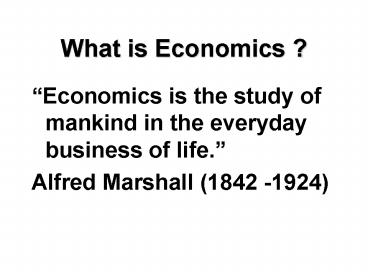What is Economics - PowerPoint PPT Presentation
1 / 25
Title:
What is Economics
Description:
What is Economics ? 'Economics is the study of mankind in the everyday ... allowance $15. z. y. x. BASIC GRAPHING. Graphing allows us to think in a marginal way ... – PowerPoint PPT presentation
Number of Views:50
Avg rating:3.0/5.0
Title: What is Economics
1
What is Economics ?
- Economics is the study of mankind in the
everyday business of life. - Alfred Marshall (1842 -1924)
2
What Is Economics ?
Economics is the study of choices made by
people who are faced with scarcity. Scarcity is
a situation in which resources are limited and
have alternative uses.
3
CHOICES
GOODS
WORK
4
ECONOMIC QUESTIONS
- What goods and services do we produce ?
- How do we produce these goods and services ?
- Who consumes the goods and services produced ?
5
SCARCITY AND PRODUCTION POSSIBILITY CURVES
- Production Possibility Curve
- A visual representation of tradeoffs that
arise in an economy that produces two goods. - A picture of the choices which can be made
when considering the production of two goods.
6
PRODUCTION POSSIBILITY CURVE(FRONTIER)
- A production possibility curve shows how all
of an economies available RESOURCES can be used
to produce various combinations of goods and
services.
7
WHAT ARE RESOURCES?
- Labor
- -- human effort used to produce
- Physical capital
- -- machines, buildings equipment
- Human Capital
- -- knowledge and skills acquired by workers
- Natural Resources (LAND)
- -- things created by acts of nature and used
to produce
8
Y
GRAPHING POSSIBILITIES
PRODUCTION POSSIBILITY CURVE
Thousands of computers per year
e
UNATTAINABLE
380
f
ATTAINABLE
300
i (inferior) (idle resources)
200
X
4
5
2
Number of Space Missions Per Year
9
SCARCITY
- The limit to available resources
- Illustrated by the envelope of the production
possibility curve. - To obtain more of one of the two choices, one
must give up more of the other choice.
10
MACROECONOMICS vs MICROECONOMICS
11
THE STUDY OF
- (MICROECONOMICS)
- choices made by individual consumers and firms
how these decisions affect the market for a
particular good or service.
- (MACROECONOMICS)
- The nations economy as a whole. Issues include
- unemployment
- inflation
- budget deficit
- trade deficit
12
MICROECONOMIC ANALYSIS
- We use microeconomic analysis
- To understand how markets work
- To make personal or managerial decisions
- To evaluate merits of public choices
13
MARKET
- An arrangement which allows buyers and sellers to
exchange money and goods.
14
THE ECONOMIC WAY OF THINKING
- John Maynard Keynes
- The theory of economics does not furnish a body
of settled conclusions immediately applicable to
policy. It is a method rather than a doctrine,
an apparatus of mind, a technique of thinking
which helps its processor to draw correct
conclusions.
15
SIMPLIFYING ASSUMPTIONS
- (Eliminate Irrelevant Detail)
- 1. People act on the basis of self interest.
- 2.People make informed decisions based on
information from - a) Producer
- b) Government.
16
GIVEN
- My income doesnt change
- No other major expense occurs
- I dont suffer a major illness or injury
- etc.....
- I should be able to buy the new stereo I would
like to own.
17
EXPLORING THE RELATIONSHIP BETWEEN TWO VARIABLES
- Variable -- A measure of something that can take
on different values.
18
EXPLORING THE RELATIONSHIP BETWEEN TWO VARIABLES
- CETERIS PARABUS
- Other things being equal to what they were
before - Other variables remain fixed.
19
GRAPHING
- Economists use this in a two dimensional form as
a way of showing the relationship between two
variables.
20
Y
BASIC GRAPHING
170
variable 2
Q U A N T I T Y
160
150
140
d
130
120
110
c
100
90
80
WEEKLY INCOME
70
60
b
50
15
40
change in weekly allowance
30
20
a
X
10
5
30
25
35
10
15
20
variable 1
QUANTITY (HOURS WORKED)
20 Weekly Allowance (No hours worked)
21
Y
BASIC GRAPHING
170
variable 2
Q U A N T I T Y
x
160
150
140
d
y
130
120
110
c
100
90
z
80
WEEKLY INCOME
70
60
b
50
15
40
change in weekly allowance
30
20
a
X
10
5
30
25
35
10
15
20
variable 1
QUANTITY (HOURS WORKED)
20 Weekly Allowance (No hours worked)
22
Graphing allows us to think in a marginal way
- Marginal - How much of a change occurs in one
variable for a specific incremental change in the
other variable. - How much of a change occurs in income for an
additional hour worked.
23
Y
SHOWING THE SLOPE
INCOME
108
60
X
10
22
HOURS WORKED
24
SLOPE
- Change in the vertical-axis variable for a given
change in the horizontal-axis variable. - Change in income for a given change in hours
worked. - Rise Run
25
Y
SHOWING THE SLOPE
INCOME
108
RISE
60
RUN
X
10
22
HOURS WORKED































